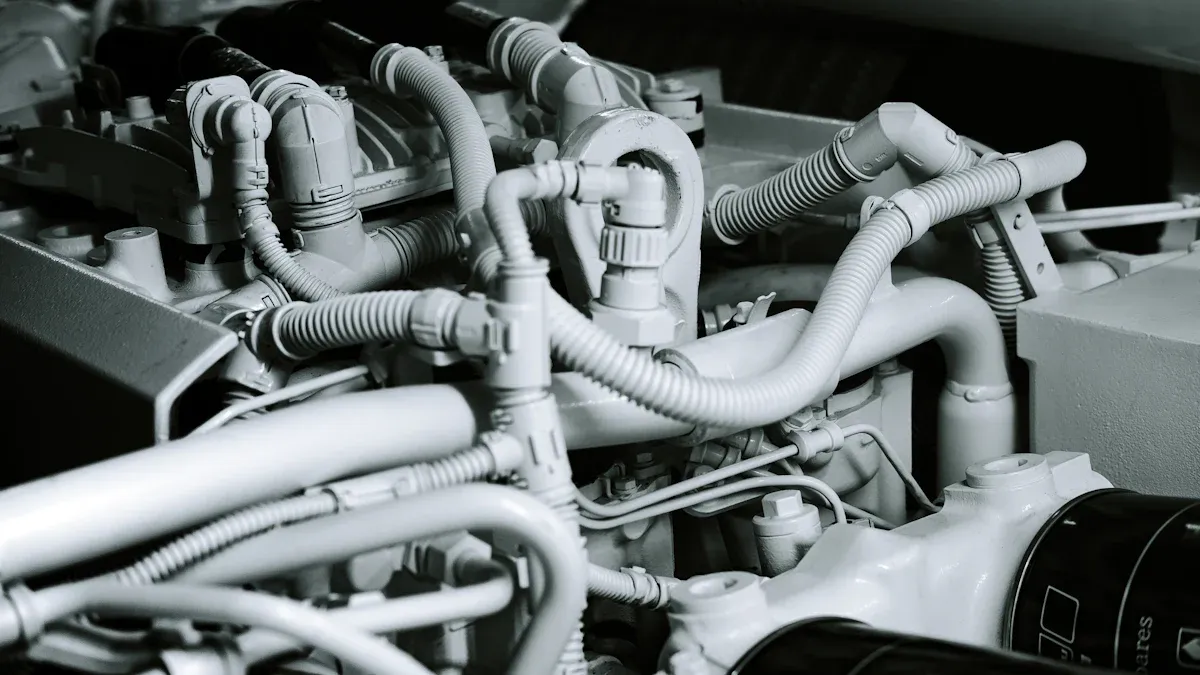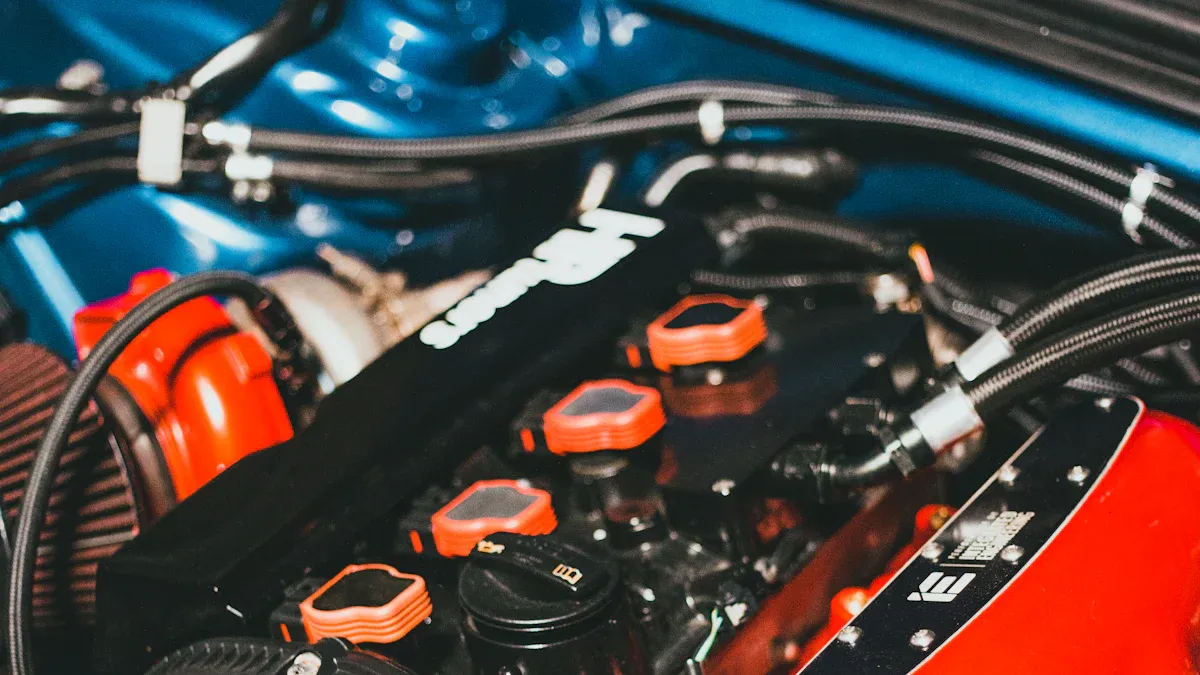
එන්ජින්වල තාපය සහ පිටාර වායු කළමනාකරණය සඳහා සමුද්ර පිටාර බහුවිධ අත්යවශ්ය වේ. හොඳින් නිර්මාණය කරන ලදවාත්තු යකඩ පිටාර බහුවිධයප්රශස්ත වායු ප්රවාහය සහතික කරමින්, එන්ජින් ක්රියාකාරිත්වය වැඩි දියුණු කරයි. මෙම සංරචක බෝට්ටු සහ යතුරුපැදි පිටාර බහුවිධ දෙකෙහිම ඉතා වැදගත් වේ, මන්ද ඒවා ගෙවී යාම අවම කර එන්ජින් ආයු කාලය දීර්ඝ කරයි. ඉහළ කාර්ය සාධන සැකසුම් පවා, උදාහරණයක් ලෙසLS7 පිටාර බහුවිධ, ඒවායේ කාර්යක්ෂමතාව මත රඳා පවතී.
සමුද්ර පිටාර බහුවිධ මොනවාද?

අර්ථ දැක්වීම සහ අරමුණ
සමුද්ර පිටාර බහුවිධසමුද්ර එන්ජින්වල අත්යවශ්ය අංග වේ. ඒවා එන්ජිමෙන් පිටවන දුම් එකතු කර පිටාර නළයට යොමු කරයි. මෙම ක්රියාවලිය මඟින් හානිකර වායූන් එන්ජිමෙන් ආරක්ෂිතව සහ කාර්යක්ෂමව පිටවන බව සහතික කරයි. මෙම බහුවිධ සාමාන්යයෙන් ප්රධාන කොටස් තුනකින් සමන්විත වේ: සම්බන්ධතා ෆ්ලැන්ජ්, ප්රාථමික නල සහ බහුවිධ ශරීරය. බහුවිධ ශරීරය එන්ජින් වායූන් පිටවීමට පෙර රැස්වන මධ්යම ලක්ෂ්යය ලෙස ක්රියා කරයි. පිටාර ප්රවාහය කළමනාකරණය කිරීමෙන්, සමුද්ර පිටාර බහුවිධ එන්ජින් ක්රියාකාරිත්වය පවත්වා ගැනීමට සහ සිරවී ඇති වායූන් නිසා සිදුවන හානිය වළක්වා ගැනීමට උපකාරී වේ.
සමුද්ර එන්ජින් පද්ධතිවල කාර්යභාරය
සමුද්ර එන්ජින් පද්ධතියක, එන්ජිම සුමටව ක්රියාත්මක වීම සඳහා පිටාර වායු ඉක්මනින් ඉවත් කිරීම සහතික කරන අතර එමඟින් එන්ජිමට නිසි වායු ප්රවාහයක් පවත්වා ගැනීමට උපකාරී වේ. මෙම සංරචකය නොමැතිව, පිටාර වායූන් ගොඩ නැගිය හැකි අතර එමඟින් එන්ජින් කාර්යක්ෂමතාව අඩු වන අතර අධික උනුසුම් වීමේ විභවයක් ඇත. මීට අමතරව, සමුද්ර පිටාර බහුවිධ නිර්මාණය කර ඇත්තේ ලුණු වතුරට නිරාවරණය වීම සහ අධික ආර්ද්රතාවය වැනි සමුද්ර පරිසරවල අද්විතීය අභියෝගවලට මුහුණ දීම සඳහා ය. මෙය සමුද්ර එන්ජින්වල කල්පැවැත්ම සහ විශ්වසනීයත්වය සඳහා ඒවා අත්යවශ්ය කරයි.
ප්රධාන විශේෂාංග සහ ඉදිකිරීම්
සමුද්ර පිටාර නල ආන්තික තත්වයන්ට ඔරොත්තු දීම සඳහා ඉදිකර ඇත. ඒවා බොහෝ විට සාදා ඇත්තේවාත්තු යකඩ වැනි කල් පවතින ද්රව්යහෝ මල නොබැඳෙන වානේ, ඒවා විඛාදනයට හා තාප හානිවලට ප්රතිරෝධී වේ. ඒවායේ සැලසුමට ජල ජැකට් වැනි විශේෂාංග ඇතුළත් වන අතර එමඟින් පිටාර වායූන් සිසිල් කිරීමට සහ අධික උනුසුම් වීම වැළැක්වීමට උපකාරී වේ. සම්බන්ධතා ෆ්ලැන්ජ් එන්ජිමට ආරක්ෂිතව ගැලපීම සහතික කරන අතර ප්රාථමික නල වායූන් බහුවිධ ශරීරයට මඟ පෙන්වයි. පිටාර ප්රවාහය ප්රශස්ත කිරීමට සහ එන්ජිම ඇඳීම් සහ ඉරීම් වලින් ආරක්ෂා කිරීමට මෙම විශේෂාංග එක්ව ක්රියා කරයි.
සමුද්ර පිටාර නල බහුවිධ එන්ජින් ක්රියාකාරිත්වය වැඩි දියුණු කරන ආකාරය

පිටාර ප්රවාහය වැඩි දියුණු කිරීම
සමුද්ර පිටාර බහුවිධපිටාර ප්රවාහය වැඩි දියුණු කිරීම සඳහා තීරණාත්මක කාර්යභාරයක් ඉටු කරයි. එන්ජිමෙන් පිටාර වායූන් කාර්යක්ෂමව නාලිකාගත කිරීමෙන්, ඒවා සුමට ක්රියාකාරිත්වය සහතික කරන අතර හානිකර වායු ගොඩනැගීම වළක්වයි. ඒවායේ ප්රාථමික නල සහ බහුවිධ ශරීරය ඇතුළුව මෙම බහුවිධවල සැලසුම වායූන්ගේ ප්රවාහය ප්රශස්ත කරයි. මෙය කැළඹිලි අඩු කරන අතර එන්ජිමට වඩා හොඳින් "හුස්ම ගැනීමට" ඉඩ සලසයි. පිටාර වායූන් ඉක්මනින් පිටවන විට, එන්ජිමට නැවුම් වාතය වඩාත් ඵලදායී ලෙස ලබා ගත හැකි අතර, එමඟින් දහනය සහ බල ප්රතිදානය වැඩි කරයි.
කාර්යක්ෂම පිටාර ප්රවාහය එන්ජිම අධික ලෙස රත් වීමේ අවදානම ද අවම කරයි. වායූන් බහුවිධය හරහා ගමන් කරන විට, පීඩනය අඩු වන අතර ඒවායේ ප්රවේගය වැඩි වේ. එන්ජිමේ ක්රියාකාරිත්වය පවත්වා ගැනීම සඳහා මෙම සමතුලිතතාවය අත්යවශ්ය වේ. උදාහරණයක් ලෙස:
- වායූන් පිටවන ස්ථානය දෙසට ගලා යන විට පීඩනය අඩු වන අතර ප්රවේගය ඉහළ යයි.
- අනෙකුත් ඉන්ධන වර්ග හා සසඳන විට ගැසොලින් එන්ජින් බොහෝ විට අඩු පීඩනයක් සහ ප්රවේගයක් පෙන්වයි.
- සමහර බහුවිධ සැලසුම් ඉහළ පීඩන අගයන් පවත්වා ගැනීමෙන් වඩා හොඳින් ක්රියා කරයි, එමඟින් ප්රවාහ කාර්යක්ෂමතාව වැඩි දියුණු වේ.
පසුපස පීඩනය අඩු කිරීම
එන්ජිමෙන් පිටවන විට පිටාර වායූන් ප්රතිරෝධයට මුහුණ දෙන විට පසුපස පීඩනය ඇතිවේ. සමුද්ර පිටාර බහුවිධ නිර්මාණය කර ඇත්තේ මෙම ප්රතිරෝධය අඩු කිරීම සඳහා වන අතර එමඟින් වායූන් නිදහසේ පිටවීමට ඉඩ සලසයි. පහළ පසුපස පීඩනය යනු එන්ජිමට එතරම් වෙහෙස මහන්සි වී වැඩ කිරීමට සිදු නොවන අතර එමඟින් ඉන්ධන කාර්යක්ෂමතාව සහ බලය වැඩි දියුණු වේ.
පසුපස පීඩනය අඩු කිරීමේදී විවිධ බහුවිධ වින්යාසයන්ගේ කාර්යක්ෂමතාව පහත වගුවෙන් දැකිය හැකිය:
| පිටාර බහුවිධ ආකෘතිය | පසුපස පීඩනය අඩු කිරීම | පිටාර ප්රවේගය වැඩි වීම |
|---|---|---|
| මාදිලිය 1 | සැලකිය යුතු | ඉහළ |
| මාදිලිය 2 | මධ්යස්ථ | මධ්යස්ථ |
| මාදිලිය 3 | අවම | අඩු |
පසුපස පීඩනය අඩු කිරීමෙන්, සමුද්ර පිටාර මනිෆෝල්ඩ් එන්ජින් වඩාත් කාර්යක්ෂමව ක්රියාත්මක වීමට උපකාරී වන අතර, එමඟින් වඩා හොඳ ක්රියාකාරිත්වයක් සහ කාලයත් සමඟ ගෙවී යාම අඩු වේ.
තාපය කළමනාකරණය කිරීම සහ අධික උනුසුම් වීම වැළැක්වීම
එන්ජින් ක්රියාකාරිත්වයේ තීරණාත්මක සාධකයක් වන තාපය කළමනාකරණය කිරීමේදීද සමුද්ර පිටාර බහුවිධ විශිෂ්ටයි. ඉහළ කාර්යසාධනයක් සහිත එන්ජින්වල 1200°F ඉක්මවිය හැකි අධික උෂ්ණත්වයන් හැසිරවීමට ඒවා ඉදිකර ඇත. නිසි තාප කළමනාකරණයකින් තොරව, එන්ජින් අධික ලෙස රත් වීමේ අවදානමක් ඇති අතර එමඟින් දැඩි හානි සිදුවිය හැකිය.
මෙම බහුවිධ කොටස් බොහෝ විට තාපය ඵලදායී ලෙස විසුරුවා හැරීම සඳහා ජල ජැකට් හෝ විශේෂිත ආලේපන වැනි විශේෂාංග ඇතුළත් වේ. ආලේපන බාධකයක් ලෙස ක්රියා කරයි, අධික තාප සමුච්චය වීම වළක්වයි සහ එන්ජින් සංරචක මත තාප ආතතිය අඩු කරයි. මෙය එන්ජිම ආරක්ෂා කරනවා පමණක් නොව දහන කාර්යක්ෂමතාවද වැඩි දියුණු කරයි.
උදාහරණයක් ලෙස, එක් පරිශීලකයෙක් වාර්තා කළේ ස්ථාවරව සිටියදී ඔවුන්ගේ බහුවිධ උෂ්ණත්වය 600°F ට වඩා වැඩි වූ බවත්, බර පැටවීම යටතේ ඊටත් වඩා ඉහළ කියවීම් ඇති බවත්ය. සමුද්ර පිටාර බහුවිධවල තාප කළමනාකරණයේ වැදගත්කම මෙය ඉස්මතු කරයි. තාප විසර්ජනය ප්රශස්ත කිරීම මගින්, මෙම සංරචක වඩා හොඳ උෂ්ණත්ව නියාමනය සහතික කරයි, තීරණාත්මක එන්ජින් කොටස්වල ආයු කාලය දීර්ඝ කරයි සහ උපරිම ක්රියාකාරිත්වය පවත්වා ගනී.
සමුද්ර පිටාර බහුවිධවල අභියෝග සහ නඩත්තුව
පොදු ගැටළු සහ කාර්ය සාධනය කෙරෙහි ඒවායේ බලපෑම
සමුද්ර පිටාර නල ඒවායේ ඉල්ලුමක් සහිත මෙහෙයුම් තත්ත්වයන් හේතුවෙන් අභියෝග කිහිපයකට මුහුණ දෙයි. එක් පොදු ගැටළුවක් වන්නේ අධික උෂ්ණත්ව වෙනස්වීම් නිසා ඇතිවන ව්යුහාත්මක විරූපණයන් ය. එන්ජින් දැඩි තාපයක් ජනනය කරන අතර, බහු අවයවය වේගයෙන් සිසිල් වන විට, එය ඉරිතැලීම් හෝ විකෘති වීමට හේතු විය හැක. ඉහළ RPM වලින් ඇතිවන කම්පන බලවේග ද හානි කරයි. කාලයත් සමඟ, මෙම දෝලනය බහු අවයවය දුර්වල කළ හැකිය, විශේෂයෙන් එහි ස්වාභාවික සංඛ්යාතය එන්ජිමේ කම්පන සමඟ සමපාත වුවහොත්.
මෙම ගැටළු සෘජුවම බලපාන්නේඑන්ජින් ක්රියාකාරිත්වය. බහුවිධයේ ඉරිතැලීම් හෝ කාන්දුවීම් පිටාර ප්රවාහයට බාධා කරයි, පසුපස පීඩනය වැඩි කරයි සහ කාර්යක්ෂමතාව අඩු කරයි. දරුණු අවස්ථාවල දී, පිටාර වායූන් එන්ජින් මැදිරියට ගැලවී යා හැකි අතර එමඟින් ආරක්ෂිත අවදානම් ඇති වේ. උෂ්ණත්වය සහ පිටාර ප්රවාහය නිතිපතා නිරීක්ෂණය කිරීම මෙම ගැටළු කලින් හඳුනා ගැනීමට උපකාරී වන අතර, මිල අධික අලුත්වැඩියාවන් හෝ එන්ජින් හානි වළක්වා ගත හැකිය.
දීර්ඝායුෂ සඳහා නඩත්තු උපදෙස්
නිසි නඩත්තුවසමුද්ර පිටාර බහුවිධවල ආයු කාලය දීර්ඝ කිරීම සඳහා යතුරයි. නිතිපතා පරීක්ෂණ මගින් ඉරිතැලීම්, විඛාදනය හෝ ලිහිල් සම්බන්ධතා හඳුනා ගැනීම කෙරෙහි අවධානය යොමු කළ යුතුය. කාබන් සමුච්චය ඉවත් කිරීම සඳහා බහුවිධය පිරිසිදු කිරීම ප්රශස්ත පිටාර ප්රවාහය සහතික කරයි. එන්ජින් උෂ්ණත්වය සහ පිටාර වායු මට්ටම් නිරීක්ෂණය කිරීම ද ඒවා උත්සන්න වීමට පෙර විභව ගැටළු හඳුනා ගැනීමට උපකාරී වේ.
ස්ථාපනය අතරතුර උසස් තත්ත්වයේ ද්රව්ය සහ ආලේපන භාවිතා කිරීමෙන් කල්පැවැත්ම තවදුරටත් වැඩි කළ හැකිය. නිදසුනක් ලෙස, මල නොබැඳෙන වානේ මැනිෆෝල්ඩ් වාත්තු යකඩවලට වඩා විඛාදනයට වඩා හොඳින් ප්රතිරෝධී වේ. තාප-ප්රතිරෝධී ආලේපන යෙදීමෙන් තාප ආතතිය අවම වන අතර හානිවීමේ අවදානම අඩු කරයි. මෙම පිළිවෙත් අනුගමනය කිරීමෙන්, බෝට්ටු හිමියන්ට වසර ගණනාවක් ඔවුන්ගේ එන්ජින් සුමටව ක්රියාත්මක කර තබා ගත හැකිය.
හානියට පත් මැනිෆෝල්ඩ් අලුත්වැඩියා කිරීම හෝ ප්රතිස්ථාපනය කිරීම
සමුද්ර පිටාර නලයක් හානිවීමේ සලකුණු පෙන්නුම් කරන විට, එය අලුත්වැඩියා කිරීමට හෝ ප්රතිස්ථාපනය කිරීමට තීරණය කිරීම ගැටලුවේ බරපතලකම මත රඳා පවතී. සුළු ඉරිතැලීම් හෝ කාන්දුවීම් බොහෝ විට වෙල්ඩින් හෝ සීලන්ට් භාවිතයෙන් අලුත්වැඩියා කළ හැකිය. කෙසේ වෙතත්, දරුණු විකෘති වීම හෝ විඛාදනය වැනි පුළුල් හානි සඳහා සාමාන්යයෙන් සම්පූර්ණ ප්රතිස්ථාපනයක් අවශ්ය වේ.
අලුත්වැඩියා සහ ප්රතිස්ථාපන තීරණ වලට බලපාන සාධක පහත වගුවේ ඉස්මතු කරයි:
| සාක්ෂි වර්ගය | විස්තර |
|---|---|
| උෂ්ණත්ව බලපෑම් | අධික තාප චක්ර නිසා ඉරිතැලීම් සහ විකෘති වීම් වැනි ව්යුහාත්මක විකෘතිතා ඇති වේ. |
| කම්පන බලවේග | ඉහළ RPM මඟින් කාලයත් සමඟ තාවකාලික හානිවලට තුඩු දෙන දෝලනයන් ඇති කරයි. |
| නඩත්තු වැදගත්කම | නිතිපතා පරීක්ෂා කිරීම් මගින් ව්යසනකාරී අසාර්ථකත්වයන් වළක්වන අතර ආයු කාලය බොහෝ ගුණයකින් වැඩි කරයි. |
කඩිනම් ක්රියාමාර්ග ගැනීම ඉතා වැදගත්. හානිය නොසලකා හැරීම එන්ජිමේ අකාර්යක්ෂමතාවයට, අධික උනුසුම් වීමට හෝ සම්පූර්ණ අසාර්ථකත්වයට පවා හේතු විය හැක. ගැටළු කලින් විසඳා ගැනීමෙන්, බෝට්ටු හිමියන්ට මුදල් ඉතිරි කර ගත හැකි අතර ඔවුන්ගේ යාත්රාව ආරක්ෂිතව සහ විශ්වාසදායකව පවතින බව සහතික කළ හැකිය.
එන්ජින් කාර්යක්ෂමව හා ආරක්ෂිතව තබා ගැනීම සඳහා සමුද්ර පිටාර නල තීරණාත්මක කාර්යභාරයක් ඉටු කරයි. නිතිපතා පරීක්ෂා කිරීම් සහ කාලෝචිත අලුත්වැඩියාවන් මිල අධික හානි වළක්වා ගැනීමට උපකාරී වේ. මෙම සංරචක ක්රියා කරන ආකාරය තේරුම් ගැනීමෙන්, බෝට්ටු හිමියන්ට ඔවුන්ගේ එන්ජින් උපරිමයෙන් ක්රියා කරන බව සහතික කළ හැකිය. මෙම කොටස් රැකබලා ගැනීම බලය වැඩි කරනවා පමණක් නොව එන්ජින් ආයු කාලයද දීර්ඝ කරයි.
නිති අසන පැණ
සමුද්ර පිටාර වායු මනිෆෝල්ඩ් සෑදී ඇත්තේ කුමන ද්රව්ය වලින්ද?
සමුද්ර පිටාර බහුවිධසාමාන්යයෙන් වාත්තු යකඩ හෝ මල නොබැඳෙන වානේ වලින් සාදා ඇත. මෙම ද්රව්ය විඛාදනයට ඔරොත්තු දෙන අතර ඉහළ උෂ්ණත්වයන්ට ඔරොත්තු දෙන අතර කටුක සාගර පරිසරවල කල්පැවැත්ම සහතික කරයි.
සමුද්ර පිටාර බහුවිධ කොපමණ වාරයක් පරීක්ෂා කළ යුතුද?
සෑම මාස හයකට වරක් සමුද්ර පිටාර නල පරීක්ෂා කරන්න. නිතිපතා පරීක්ෂාවන් ඉරිතැලීම්, විඛාදනය හෝ කාන්දුවීම් කලින් හඳුනා ගැනීමට උපකාරී වන අතර එමඟින් ඒවා වළක්වා ගත හැකිය.මිල අධික අලුත්වැඩියාවන්සහ එන්ජිම කාර්යක්ෂමව ක්රියාත්මක වන බව සහතික කිරීම.
ඉඟිය:ප්රශස්ත ක්රියාකාරිත්වය සහ දීර්ඝායුෂ සඳහා සැමවිටම නිෂ්පාදකයාගේ නඩත්තු මාර්ගෝපදේශ අනුගමනය කරන්න.
හානියට පත් මැනිෆෝල්ඩ් අලුත්වැඩියා කළ හැකිද, නැතහොත් ඒවා සැමවිටම ප්රතිස්ථාපනය කළ යුතුද?
කුඩා ඉරිතැලීම් වැනි සුළු හානි බොහෝ විට අලුත්වැඩියා කළ හැකිය. කෙසේ වෙතත්, විකෘති වීම හෝ පුළුල් විඛාදනය වැනි දරුණු ගැටළු සඳහා සාමාන්යයෙන් ආරක්ෂාව සහ ක්රියාකාරිත්වය සහතික කිරීම සඳහා සම්පූර්ණ ප්රතිස්ථාපනයක් අවශ්ය වේ.
පළ කිරීමේ කාලය: 2025 අප්රේල්-14



